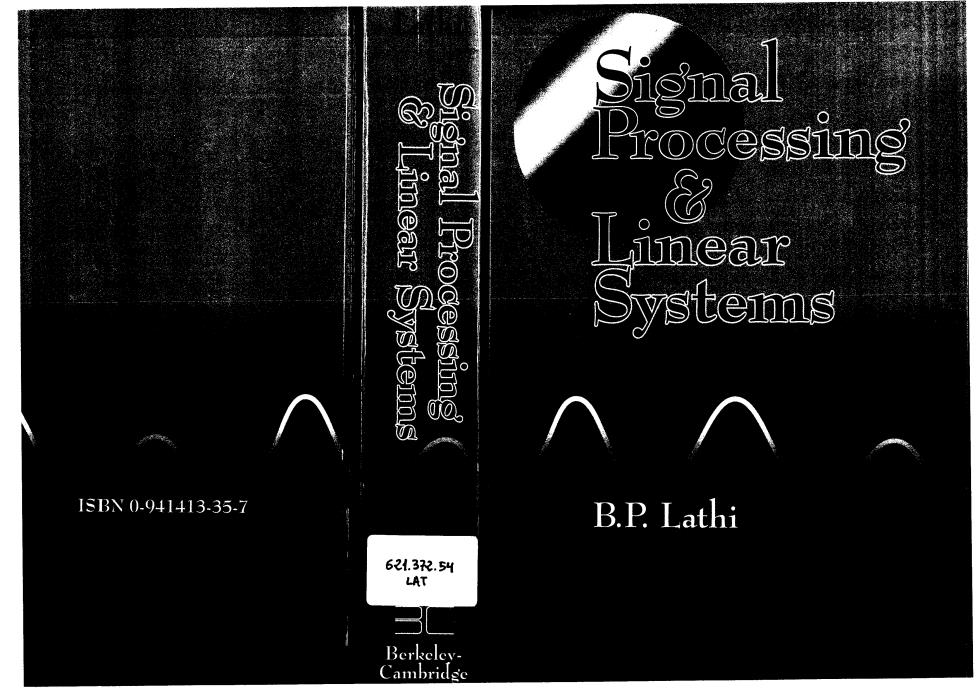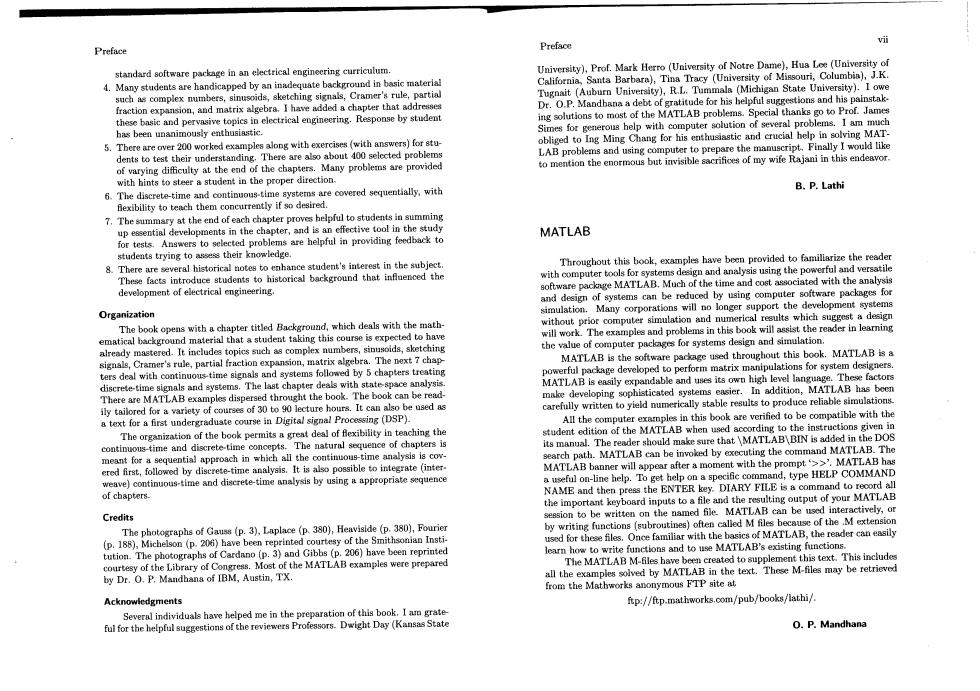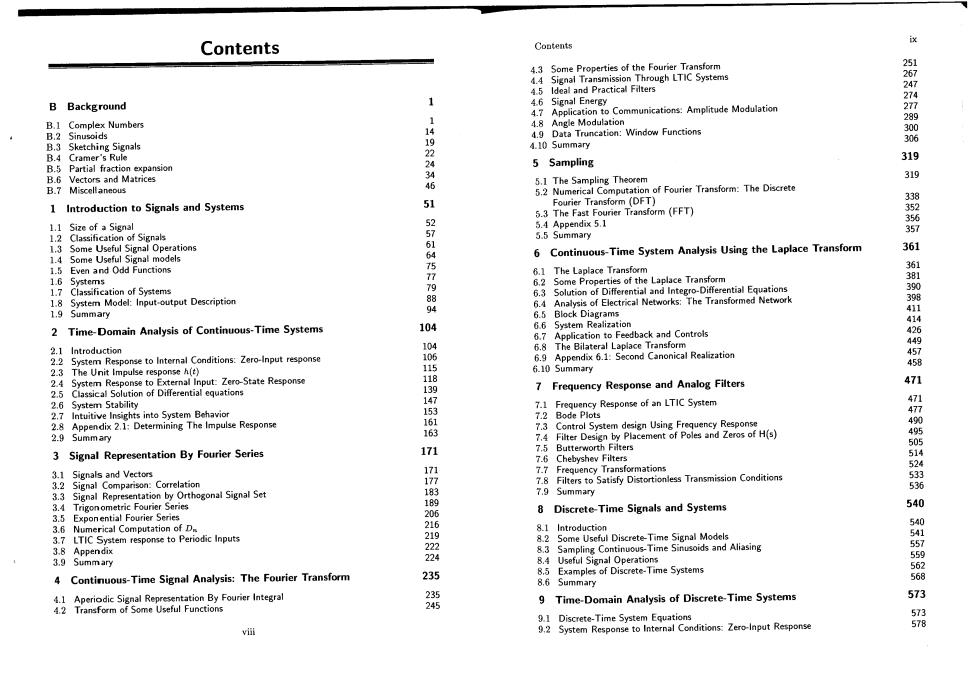
Sigmal Udy U2 Processing Lnear Systems ISBN0-941413-35-7 B.P. Lathi 621.372.54 LAT Berkelev- Cambridge

vi Preface Preface standard software package in an clectrical engineering curriculum. University),Prof.Mark Herro(University of Notre Dame),Hua Lee (Universi ny students are handicapped by an inadequate background in basic materia oids,sketching signals,Cramer's rule,partial and matrix algebra.I have added a chapter that addresses and pervasive topics in electrical engineering.Response by student nerous help with computer solution of several pro MAT 900 with erercises /with answers)for stu ng Ming Chang for his enthusiastic and crucia LAB problems and using computer to prepare the manuscript. uld like There are also about 400 selccted problems i in this er at the end of the chapters.Many problems are provided ntion the enormous but invisible sacrifices of my wife Rajani student in the proper direction. conti equentially,with B.P.Lathi 0. desired. 7.The summary at the end of eac pter prove up essential developments in the chapter,and tool in the stud MATLAB for tests.Answers to sel viding feedback to Throughout this book,examples have bo n provided to famillarize the reader 8.There are several historical notes to enhance stu dent' in the werful and versatile These facts introduce students to historical kgrou time and cos asociated with the analysis development of electrical engineering. and design of systems can b d b using computer software packages for Organization simulation.Many corpor ort the development systems math esults which suggest a design The book opens with a chapter titled Background without prot comp natical background material that a student taking this co course work.The already mastered.It includes topics such as complex ds the value of cmputer packages for systems design and simulation. signals,Cramer's rule,partial fraction expansion,m The MATLAB is the software package used throughout this book.MATLABis a ters deal with continuous-time signals an owerful package developed to perform matrix ma discrete-time signals and systems.I he MATLAB is easily expandable and uses its own There are MATLAB examples dispe the book can be r ead make developing sophisticated sys ddit MATLAB has boen It can also be used as ly tailored for a varety of courses a text for a first undergraduate couse in Digital sing (DSP) The organization of the book permitsgre deal ofx in teaching the student edition of the MATLAB when used aco continuous-time and discrete-time conce The natu rch path.MATLAB can be invoked by executing the comman nd MATLAB The meant for a sequential approach in which all the contim ered first,followed by discrete-time analysis. to i ate(in MATLAB banner will appear after a moment with the prompt MATLAB has It I weave)continuous-time and discrete-time analysis by usinga appropri seful on-line help.To get help on a specific comm HELP COMMAND P of chapters. MATLAB be us Credits to he written on the named file MATl io The phot p.380,F6 the 49 d for these files.Once familiar with the ba sics of MATLAB,t r can easily tution.The photographs of Cardano(p.3)and Gibbs(P .206)h e been reprinte learn how to write functions and to use MATLAB's exis courtesy of the Library of Congress.Most of the MATLAB example s were prep The MATLAB M-files have been created to suppleme all the examples solved by MATLAB in the text. These M-files may by Dr.O.P.Mandhana of IBM,Austin,TX. from the Mathworks anonymous FTP site at Acknowledgments ftp://ftp.mathworks.com/pub/books/lathi/ Several individuals have helped me in the preparation of this book.I arn grate ful for the helpful suggestions of the reviewers Professors.Dwight Day(Kansas State O.P.Mandhana

Contents Contents ix 25524 ldeal and Practical Fiters B Background Signal Energy mmunications:Amplitude Modulation B.1 Complex Numbers 1 Signals er's Rule 4924 9 Data Truncation:Window Functions 4.10 Summary Partial fraction expansion 5 Sampling 319 B 6 Vectors and Matrices 5.I The Sampling Theorem 319 B.7 Miscellaneous 5.2 Numerical Co of Fourier Transform:The Discrete 1 Introduction to Signals and Systems Fourier Transfo 5.3 The F ansform (FFT) 1.1 Size of a Signal 3 6 Continuous-Time System Analysis Using the Laplace Transform 361 Od Functions 16 Systems :579 Some Properties of the Laplace Trans 61 orm 1.7 Classification of Systems 390 6.3 System Model:Input-output Descriptior 6.A Summary 2 Time-Domain Analysis of Continuous-Time Systems 104 Introduction 104 The Bilateral Laplace Transform The Unit nse tonteral Canditions:Zero-input response 话139 6.9 Appendix 6.1:Second Canonica Realization 2.3 6.10 Summary 2.4 stem Re onse to External Input:Zero-State Response 气0 ifD浦eretia 7 Frequency Response and Analog Filters 471 25 System Stability The ulse Response 12131 stem design Using frequency Response by Placement of Poles and Zeros of H(s) 3 Signal Representation By Fourier Series 171 75 Butterworth Filters Chebyshev Filters n:Correlation atisfy Diste Hess Transmission Conditions Signal Re sentation by Orthogonal Signal Set 3.4 Trigonometric Fourier Sories 8 Discrete-Time Signals and Systems 540 3.5 Expon ential Fourier nerical Computatio ystem response Pe 82 Sampling Continuous-Time Sinusoids and Aliasing 45 3.93 8.4 Useful Signal Operations 4 Continuous-Time Signal Analysis:The Fourier Transform 235 Examples of Discrete-lime System 8.6 Summary 305 9 Time-Domain Analysis of Discrete-Time Systems 573 6 vi

Appendix 9.1:Determining Impulse Response 9.8 Summary 10 Fourier Analysis of Discrete-Time Signals 617 10.2 AperiodicS ion With the Continuous-Time Fourier transform Discrete-Time Linear System analysis by DTFT 10.6 Signal Processing Using DFT and FFT Background 10.7 Generalization of DTFT to the 2-Transform 10.8 Summary 11 Discrete-Time System Analysis Using the 2-Transform 668 The topics discussed in this chapter are not entirely new to students taking ave already studicd many of these topics in earlier courses or are 11.1 The 2-Transform of the 2- 68 this them from your previous training.Even so,this background m 12 es a review because it is so pervasive in the area of signals and systems Syste 115 Connection Between the Laplace and the 2-Transform 时oaae 11.6 Sampled-Data(Hybrid)Systems It will also be helpful as reference material in your future professional career. The Bilateral Z-Transform 1.8 Summary 710 B.1 Complex Numbers 12 Frequency Response and Digital Filters 716 an integral Pole-Z 5 part of the modern number system. imaginary ponse numbers,sometimes seem mysteriou 12.4 Filter Des ign Criteria 12.5 Recursive Filter Design:The Impulse Invariance Method 强 rives from their unfamilia "for the tern im- Recursive Filter Design:The Bilinear Transformation Method 740 mediately prejuc me other name,they wo ld have be just as irrational numbers or negative nu ers were.Ma physical meaning to im this effort is needless In moath we wish as loug as internal 13 State-Space Analysis 784 ch would have been to define a symbol operty i2=-1.The history of Introduction “imag ntitie 4f re for Determining State Equations enfamiliar and held in abborrence until 13.3 olution of State Equations ity m 13.4 Linear Transformation of State Vector historical 13.5 B.1-1 A Historical Note 189 Among early people the number system consisted only of natural umber Answers to Selected Problems (positive integers)neec h 843 arrows.These people had no ne and one-half Supplementary Reading children or three and one-fourth cows Index 844

2 Background B.1 Complex Numbers However,with the advent of agriculture, and so on.The number s ystem.therefore was extended to include fractions.The ancient Egyptians and Babylonians knew how to handle fractions,but Pythagoras discovered that some numbers (like the diagonal of a unit square)could not expressed as a whole number or a fraction.Pythago regarded numbers as the essence and principle of all things in the unive se.was so appalled at his discovery that he swore his followers to secrecy and imposed a death penalty for divulging this secret.!These numbers,however,were included in the number system by the time of Descartes,and they are now known as irrational numbers Until recently,negative numbers were not a part of the number system.The concept of negative numbers must have appeared absurd to early man.However, the mdievdcleareof theofp Ihey were also the nrst to recognize the existence of a ()ot onh The works of Bhaskar (1114-1185)on arithmetic (Lilaveti) cemn but also give rules for deal rs have two e and Gerolamo Cardano (left)and Karl Friedrich Gauss(right). imaginary numbers plausible and acceptable to early mathematicians.They could ducats A目th -1as pure nonsense when it appeared as a solution to to write the differ 2 stood at of a his no n154 on the ebit side again agna (The Grea!Ar aic wor pegative numbers.Theac ade it possible to solve In this ok tie gave a ng a genera ations such asr+5=0.which had no solution before.Yet for equations such as ,the in an intermediate step.According mpletely new kind of number theDuring the time of Deacarte Net 3+ar+bm0 (or compex)numbers came to be accepted as part of the number system,bu is given by they were still regarded as algebraic fiction.The Swiss mathematician Leonhard Euler introduced the notation i (for imaginary)around 1777 to represent v-1. -多+V度+器+-身-V厚+器 Electrical engineers use the notation j instead of i to avoid confusion with the notation i often used for electrical current.Thus 众心ond3ti0+6a-0=0eta-6-一 equation to obtain 2=-1 and 王=10+v108+10-108=20.392-0.392=2 =j We can readily verify that 2 is indeed a solution of 3+6r-20.=0.But when This notation allows us to determine the square root of any negative number.For Cardano tried to solve the equation-15x-4=0 by this formula,his solution example. V-4=A×-1=±2j When imaginary numbers are included in the number system,the resulting numbers are called complex numbers. Origins of Complex Numbers 之 ation with real roots that made